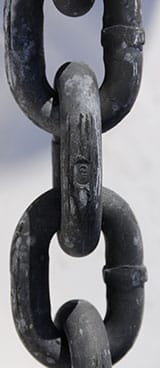All chain’s the same, right? Well, no. There’s actually a variety of types and grades of anchor chain that cruising sailors should know about. What follows is a primer on understanding anchor chain and how to use it properly.
Types of Anchor Chain

Your Chain Explained
The most popular varieties of galvanized-steel windlass chain include high-test or grade 40 (usually marked HT, G4, or HT4); triple B or grade 30 (marked as BBB or 3B); and proof coil, also grade 30 (often marked PC, PC3, or G3). Each has attributes and shortcomings. BBB and proof coil are made from low-carbon steel; heat-treated high-test is made from a high carbon-manganese alloy.
HT chain is widely used because of its “strength-to-link” factor: Its working load limit is nearly twice that of BBB chain, and it has the highest weight-to-working load ratio. In other words, it allows the use of a thinner link, which means more chain can be stored in a given chain locker. Its links are also windlass calibrated, which means that they should fit any wildcat with an “HT” designation. Such links also tend to resist tangling in the locker.
Most PC chain is designated as “non-calibrated for windlass use.” This means it’s not designed to be used with a windlass wildcat. Period. Unfortunately, this caveat is unlikely to be stamped directly on the chain, so you can never be certain if the chain falls into this category. (If chain is verifiably approved for your windlass, it may be used for anchor rodes.) PC chain has roughly the same working load as BBB chain and the same number of links per foot as HT; for 3/8-inch chain, the ratio is 9.8 links per foot of chain. It’s worth noting that some windlass manufacturers, for obvious reasons, don’t offer a PC wildcat. If someone offers you a pile of cheap PC chain, beware.

Most high-quality chain from reputable manufacturers is embossed with a designation indicating the grade. Without one, you’ll be guessing about the chain’s strength. Failing to use chain designed for a specific windlass wildcat can lead to potentially dangerous overrides (above). This chain is in no-man’s land: It can’t be lowered or raised.
At one time, though not the strongest option for a given link size, BBB was the most popular anchor chain because it’s specifically calibrated for windlasses. But its primary attribute is its weight. A 100-foot length of 3/8-inch BBB weighs approximately 165 pounds, while identical lengths of HT and PC weigh 153 and 140 pounds, respectively. With anchor rodes, weight is critical. Every additional pound increases a chain’s catenary, the sag induced by the deployed chain. Still, many builders and sailors choose HT over BBB because, for the same tensile strength, they can fit more of it into cramped chain lockers. And, again, it’s less prone to tangle.
Maintaining Your Marine Chain
Inspect your marine chain carefully and regularly. Make certain that the links fit evenly into each recess of the wildcat and that the wildcat is equipped with a stripper, a steel bar that separates tensioned chain from the wildcat as it’s being retrieved. If the stripper is absent or bent, jams are more likely to occur. Finally, be sure that the bitter end of the chain is attached to the vessel via a spliced-on section of line that’s long enough to reach the deck. The splice should fit easily through the chain hawser. If you’re dragging onto a lee shore or you’re about to be run down, this line acts as a safety valve allowing you to quickly cut the boat free from the ground tackle.








